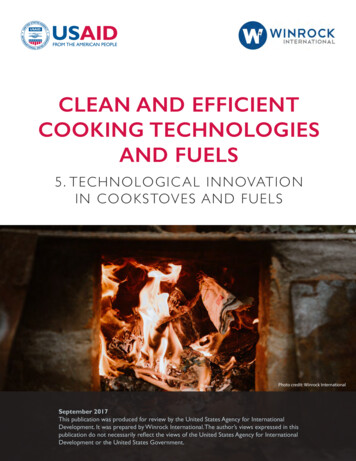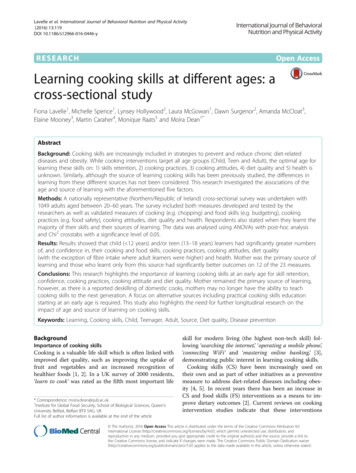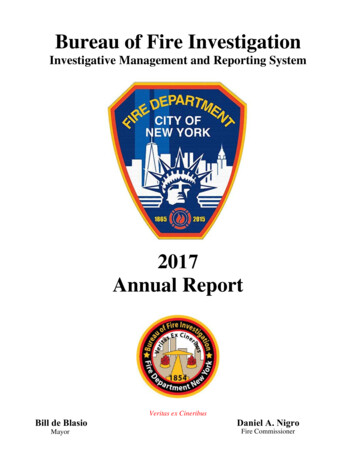
Transcription
CLEAN AND EFFICIENTCOOKING TECHNOLOGIESAND FUELS3. C L I M ATE I M PAC TS OF TRA D ITION ALS TOV E S A ND FUE LSPhoto credit: Winrock InternationalSeptember 2017This publication was produced for review by the United States Agency for InternationalDevelopment. It was prepared by Winrock International. The author’s views expressed in thispublication do not necessarily reflect the views of the United States Agency for InternationalDevelopment or the United States Government.
CLEAN AND EFFICIENT COOKING TECHNOLOGIES AND FUELS3. CLIMATE IMPACTS OFTRADITIONAL STOVES ANDFUELSBurning solid fuels for cooking emits some of the most significant contributors to global climate change, andunsustainable wood harvesting contributes to deforestation, reducing carbon uptake by forests. Increasedfuel efficiency and the introduction of alternative fuels, utilizing renewable fuel sources, can reduce climateemissions caused by cooking. To achieve a significant climate impact, uptake of clean and efficient stoves andfuels must be large, and stoves must perform well in homes. Although not all climate impacts of cooking arefully understood, existing methodologies estimate that clean and efficient stoves can save anywhere from 1-3tonnes of CO2e/stove/year, with 1-2 tonnes being most common.Photo credit: Winrock InternationalCLIMATE IMPACTS OF TRADITIONAL STOVES AND FUELSHTTPS://WWW.USAID.GOV/ENERGY/COOKSTOVES
CLEAN AND EFFICIENT COOKING TECHNOLOGIES AND FUELSWHY IT MATTERSBurning solid fuels for cooking emits some of the most significant contributors toglobal climate change, but the climate impacts of cooking, and of shifts to cleancooking, still require further research and exploration.1. If your project has climate impact goals, make sure the technologyyou’re promoting has been tested for total emissions, or par tner with areputable testing lab to test the technologies, including in the field, priorto dissemination, to ensure emissions reductions.BEST PRACTICES2. Investigate carbon finance oppor tunities, but ensure that carbon revenuesare not essential to the project’s overall sustainability. Carbon prices canfluctuate dramatically, and carbon markets require significant upfrontresources and time to navigate, which must be considered and plannedfor during project design.CARBON FINANCE / CALCULATING CLIMATE IMPACTSAccording to Bailis et al, over half of all wood harvested worldwide is used as fuel, and biomass used for cooking is 2734% non-renewable (unsustainably harvested), with large variations by country/region. Burning solid fuels releases carbondioxide, methane and other ozone producing gases such as carbon monoxide, as well as short-lived climate forcers likeblack carbon. Up to 25% of global black carbon emissions are estimated to come from burning solid fuels for householdenergy needs. According to a 2013 report by the Stockholm Environment Institute, the global potential for greenhousegas (GHG) emission reductions from improved cookstove projects is estimated at 1 gigaton of carbon dioxide equivalent(CO2e) per year. Carbon markets can incentivize reducing these emissions.Carbon finance refers to the purchase of greenhouse gas (GHG) emission reduction credits from a registered projectthat has been approved to generate those carbon credits by any number of governing bodies that govern the carbonmarkets. To claim carbon credits, a project must first be registered to an international carbon standard in the complianceor voluntary market. The primary compliance mechanism is the Clean Development Mechanism (CDM), and the GoldStandard is the primary voluntary carbon standard. These carbon standards have sets of rules that determine what aproject must do to become registered, how credits will be calculated, and what monitoring is required to verify emissionsreductions. While the whole system is based on getting results at scale, there are mechanisms for smaller-scale projectsto receive carbon finance through joining a small-scale Program of Activities (PoA), which is an aggregation of smallerprojects. Also worth noting is that, while there have been linkages made between cookstoves and REDD goals, to dateefforts to promote cookstoves as part of REDD financing mechanisms have been limited.Carbon finance developers can help navigate the process of setting up a carbon program for a fee, as it can becomplicated for those new to the system. As of 2016, carbon prices are very low, and the primary option for carbonrevenues is to sell credits to a select few national governments who are occasionally willing to sign forward contracts,(wherein the price of carbon is set in advance for the duration of the project). Forward contracts are scarce but possiblefrom EU country governments through CDM, or through the World Bank’s Carbon Initiative for Development (CIDEV) fund. Some companies are also willing to pay higher prices through forward contracts as part of corporate TE IMPACTS OF TRADITIONAL STOVES AND FUELS
CLEAN AND EFFICIENT COOKING TECHNOLOGIES AND FUELSresponsibility initiatives. Under any of these scenarios, credit payments are received only after the project is in fullimplementation (e.g., after stoves are already being used in homes), which can limit the involvement of organizationsthat need upfront financing to get programs started, or to pay for the M&E requirements and verification costs that areneeded to start and continue receiving payments.At the Paris climate conference (COP21) in December 2015, 195 countries adopted the first-ever universal, legallybinding global climate deal, which is due to enter into force in 2020. While a carbon trading system including carbonoffsets is expected to be part of the new system, what form such a market will take is unknown.Various models exist to calculate carbon impacts. A Global Alliance-supported research project entitled “Geospatial Analysisand Modeling of Non-Renewable Biomass: WISDOM and beyond” developed two models to simulate the impacts ofwoodfuel consumption on forest resources at different scales. The first relies on a web-based map server that shows theresults of a pantropical woodfuel sustainability analysis. Users can download estimates of overall woodfuel consumptionand non-renewable wood harvesting for any geographic unit of interest. These data can be used to calculate CO2 emissionsresulting from woodfuel consumption and estimate the potential benefits of wood energy interventions in different regions.The second, NRBv1.0, is a software tool that assesses woodfuel-driven forest degradation or deforestation for smallergeographic regions. The tool uses several freely available software packages to simulate wood extraction and woody biomassregeneration within a user-defined geographic region. The objectives of simulations are 1) to demonstrate where and whenwoodfuel demand is likely to contribute to forest degradation and 2) model the impact of interventions that aim to reducewoodfuel consumption.USAID and Winrock developed the AFOLU carbon calculator as part of the USAID Carbon Reporting Initiative. Thecalculator uses the Intergovernmental Panel on Climate Change (IPCC) accounting methods to estimate the potentialclimate benefits of different types of projects, including clean cooking interventions.BLACK CARBONBlack carbon is a small, dark particle that is released as a result of incomplete combustion of solid fuels. Although blackcarbon is a particle rather than a greenhouse gas, it is the second largest climate warmer, after carbon dioxide. A 2013study by black carbon expert Tami Bond and 30 other experts published in the Journal of Geophysical ResearchAtmospheres says the current influence of black carbon on warming the climate may be about two-thirds of the effectof carbon dioxide. Unlike carbon dioxide, the atmospheric lifetime of black carbon is only a few days, so reducingblack carbon would bring about a more rapid climate response than reductions in carbon dioxide and other long-livedgreenhouse gases alone. While black carbon definitely has climate warming effects, other aerosols that are lighter in colorare also emitted from the burning of biomass and fossil fuels, and these produce a cooling effect. Further complicating theissue, the impact of black carbon reductions on climate depends on geographical characteristics. For example, the warmingpotential of black carbon abated in the Himalayas (due to white surfaces) is much greater than in central Africa.According to Dr. Veerabhadran Ramanathan, professor of climate sciences at the Scripps Institution of Oceanography atUC San Diego and leading expert on the role of black carbon in regional and global climate change, it is probable thatgreenhouse gas emissions to date will cause warming of close to 2 degrees Celsius, but that with available technologies, itis possible to cut short-lived climate pollutants drastically. He and colleagues note that reductions of 30% for methane, 75%for black carbon, and nearly 100% for the most potent hydrofluorocarbons are achievable. This would avoid up to 0.6 Cof warming by mid-century, while also slowing the rise in sea levels, the melting of glaciers, and the retreat of the Arctic icecap1. Dr. Ramanathan leads Project Surya, the only project currently monetizing black carbon. Project Surya aims to mitigatethe regional impacts of global warming by reducing atmospheric concentrations of black carbon, methane, and ozone,1. ATE IMPACTS OF TRADITIONAL STOVES AND FUELSHTTPS://WWW.USAID.GOV/ENERGY/COOKSTOVES
CLEAN AND EFFICIENT COOKING TECHNOLOGIES AND FUELSvPhoto credit: Project Gaiathrough the introduction of cleaner cooking technologies, and is currently working in India.In 2015 The Gold Standard launched a methodology for quantifying and monitoring emissions from black carbon andother short-lived climate pollutants, in an effort to drive finance into projects that provide an immediate and measurableimpact on mitigating climate change at a local level. This methodology quantifies the emissions of black carbon and othershort-lived climate pollutants when wood, charcoal, animal dung or coal are burned for cooking. It also measures thereductions of these emissions when improved cookstove technologies or clean burning fuels are introduced. Rather thancarbon credits, this methodology results in the issuance of black carbon certificates. There have been no transactions todate using this methodology, perhaps because of the absence of a measure like CO2e that is widely understood and easyto monetize. Developing such a measure, or link to CO2e, could benefit the monetization of the climate co-benefits.Many of today’s more efficient cookstoves have been shown to reduce fuel use by 30-60%, and provide cleaner, morecomplete combustion, which can result in fewer greenhouse gas and black carbon emissions and reduce impacts onforests. Recent evidence also demonstrates that advanced (efficient and low emission) cookstoves and fuels can reduceblack carbon emissions by 50-90%. Emission reductions are not guaranteed to accompany fuel reductions, however, so it’simportant to measure emissions in addition to fuel use. The Gold Standard black carbon methodology includes a numberof approved black carbon monitoring devices and CLIMATE IMPACTS OF TRADITIONAL STOVES AND FUELS
emissions caused by cooking. To achieve a significant climate impact, uptake of clean and efficient stoves and fuels must be large, and stoves must perform well in homes. Although not all climate impacts of cooking are fully understood, existing methodologies estimate that clean and efficient stoves can save anywhere from 1-3 tonnes of CO 2










